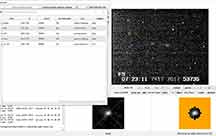

Iduna is a large asteroid and the path for this covers all of the southern Santa Cruz Mtns and south Bay, and most of the way up Mt Hamilton Rd. The asteroid is dim, but it happens in a moonless sky permitting adequate integration, and most important, happens with the asteroid close to its stationary point and moving very slowly among the stars. The full duration is 22 seconds, so there should be no way to not be able to integrate long enough to get this one. It happens just after midnight
Alt=38, Az=98 high in the east. In the middle of Pegasus, 10 degrees left of Enif (tip of horse's nose)
Strategy: This event is about 2 hours after the much brighter event by Portlandia; a W=7.8 magnitude event 8.2s max duration, at 22 degrees altitude in the south, in Lupus, and which requires being up Mt Hamilton Rd to escape fog and get into the path. Do we want to stay put for 2 hrs waiting for this event, or instead pack up and drive back to Summit Rd and still be above the fog and save ourselves some sleep time? Or, just skip Portlandia and do Iduna from Bonny Doon? Karl's in the path for Iduna, but not Portlandia.
 |
 |
All 3 of our team got data on this one
I positioned at the end of the airfield at Sunlit Lane, at the west end of the clearing. I was at 8x, probably should have done 4x, but I got on target later than I wanted, due to telescope pointing error and drift. I got a later start than desired as well, but comfortably got the main event. 22.7s duration. There's a suspicious spike back to normal brightness a couple of seconds after the D. Couldn't be a graze because Liu and Osaki had 20 and 18s events far to the other side of me. Must be noise.
I used ref1 for the reference star, after finding optimal smoothing, I tried time offset but both directions made the flatness worse. That's indicative that there were no faint wisps of smoke or other aerosols or clouds drifting through unseen.
magDrop report: percentDrop: 35.4 magDrop: 0.475 +/- 0.036 (0.95 ci)
DNR: 2.62
D time: [07:18:14.7032]
D: 0.6800 containment intervals: {+/- 0.0740} seconds
D: 0.9500 containment intervals: {+/- 0.2244} seconds
D: 0.9973 containment intervals: {+/- 0.5949} seconds
R time: [07:18:37.4231]
R: 0.6800 containment intervals: {+/- 0.0740} seconds
R: 0.9500 containment intervals: {+/- 0.2244} seconds
R: 0.9973 containment intervals: {+/- 0.5949} seconds
Duration (R - D): 22.7199 seconds
Duration: 0.6800 containment intervals: {+/- 0.1195} seconds
Duration: 0.9500 containment intervals: {+/- 0.3293} seconds
Duration: 0.9973 containment intervals: {+/- 0.7276} seconds
 |
 |
 |
 |
 |
 |
 |
Observed at 4x from "the Berm" on Empire Grade. Got a solid 22.7s event
magDrop report: percentDrop: 37.0 magDrop: 0.502 +/- 0.039 (0.95 ci)
DNR: 1.39
D time: [07:18:14.0220]
D: 0.6800 containment intervals: {+/- 0.0890} seconds
D: 0.9500 containment intervals: {+/- 0.3690} seconds
D: 0.9973 containment intervals: {+/- 0.9265} seconds
R time: [07:18:36.7110]
R: 0.6800 containment intervals: {+/- 0.0890} seconds
R: 0.9500 containment intervals: {+/- 0.3690} seconds
R: 0.9973 containment intervals: {+/- 0.9265} seconds
Duration (R - D): 22.6890 seconds
Duration: 0.6800 containment intervals: {+/- 0.1517} seconds
Duration: 0.9500 containment intervals: {+/- 0.4608} seconds
Duration: 0.9973 containment intervals: {+/- 1.0025} seconds
 |
 |
 |
 |
 |
Karl got a successful recording too - this time on the new setup using his new PC laptop and the Startech cable I gave him. He's getting trained on PyMovie / PyOTE and then his results will show up here. A review on his computer showed he had a long occultation as well.